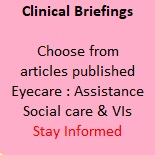Ophthalmology and OMPs
NHS England publishes new eye care guidance
NHS England publishes new eye care guidance
The NHS National Eye Care Recovery & Transformation Programme published three key documents this week.
1. Optimising existing locally commissioned primary care optometry.
This guidance reminds commissioners that hospital eye care services in England are under significant pressure and that local commissioners need to secure safe and sustainable models of care. It recommends they do this by making better use of the expertise and infrastructure in primary eye care, stating:
- “Improved utilisation of primary eye care provides a more convenient and accessible setting for patients. It helps manage the growing demand sustainably and mitigates the increasing strain on hospital eye services. It gives the patient greater continuity of care and improves patient experience and opportunity for self-care. This approach to supporting recovery makes optimal use of an existing sizeable primary eye care workforce, utilising first contact practitioners to manage low-risk patients with long-term conditions.”
It specifically advises local commissioners to review and maximise throughput under existing extended primary eye care services contracts for:
- Urgent Eye Care Services – e.g. MECS, CUES, PEARS or equivalent
- Cataract pathway (both pre and post-operative)
- Glaucoma filtering services (repeat measures and enhanced case finding)
- Glaucoma monitoring
One key statement says:
Primary eye care provides a coordinated and comprehensive service as part of the broader eye care delivery the wider NHS and should be utilised to support eye care services to meet local population needs.
2. Reducing frequent and unnecessary follow-ups.
This draft guidance provides suggestions on how hospital eye departments can reduce follow-up appointments and increase capacity to manage more urgent, complex or sight-threatening conditions. It includes recommending the “optometry first model which better utilises optometrists”.
Another Key Statement:
The intention is to rapidly increase eye care capacity to see patients with urgent, complex or sight-threatening disease and prevent permanent visual loss in delayed patients. By
reducing or personalising the frequency of appointments where appropriate, and eliminating those that are unnecessary, patients can receive an improved outpatient experience and providers can release significant outpatient capacity for re-allocation to delayed or higher risk patients.
























